I don't know if I'm going to be buying a PS5 anytime soon (or ever), so I may not have an opportunity to play Miles Morales, which is Insomniac's follow-up to its smash hit 2018 game Marvel's Spider-Man. Instead, I decided to go back and play the DLC for the 2018 game, "The City That Never Sleeps", which I had bought, but never got around to playing. This got me thinking more about how Insomniac implemented the web-swinging mechanics, and what I hope they'll do to iterate and improve the mechanic in future games.
This blog post is a transcript of the video essay above.
I had previously mentioned Marvel's Spider-Man essay about open world gaming's possible recent inflection point, but I didn't go into much detail. Basically, I just threw it in as an example of a recent open world game in which the traversal of the map had a large mechanical focus, turning the map into more of a play space and less of a convoluted, time-wasting mission-select screen. I didn't spend more time talking about Spider-Man, however, because as much as I like Insomniac's game, and as fun as the web-swinging is, I still felt like the web-swinging traversal in that game was pretty simple, and the environment did not act as much of an obstacle to the level of the other games in those videos.
Besides, Insomniac's Spider-Man didn't stray very far from the boring checklist-inspired open world design that my earlier videos were railing against. Traversal doesn't consume resources other than the player's time, and the player isn't responsible for balancing Peter's heroic and personal lives (the tension between the two has always been a big part of the Spider-Man story), nor are there any other mechanics that try to pull the player towards one set of content to the exclusion of another, and so where you are on the map, where you're going, and how you chose to get there is largely meaningless. It's any other open world game you've played in the last 10 years. The web-swinging is just a much more stylish and spectacular method of moving from filler content to filler content.
Spider-Man games make for an interesting case study in open world game design.
Spider-Man games in total do represent their own interesting microcosm of the virtues of open world, sandbox game design, and also of the ways in which open world games can fall flat on their faces and fail miserably. Spider-Man could make for an interesting case study to go along with Death Stranding.
Since the landmark Spider-Man 2 movie tie-in game, mainstream Spider-Man games have mostly been open world games. The most notable exceptions being Beenox's Shattered Dimensions (which was pretty good) and Edge of Time (which was awful). All the other Spidey games that I've played have been open world games in which you web swing around a virtual Manhattan to reach story missions or to thwart ambient crimes. The quality of these games has been very hit-or-miss, but (as we'll discuss soon) many of them still have their unique merits.
Beenox's Shattered Dimensions and Edge of Time are notable Spider-Man games that are not open world games.
Web of Shadows, for instance, had lots of problems with its writing, pacing, and animation, but its novel aerial and wall-crawling combat mechanics made excellent use of the map's verticality in ways that other Spidey games (and open world games in general) rarely even approach. I won't be talking much about this game because I traded in my copy a long time ago, and I don't feel like blowing $45 of Patreon contributions on a game that I'll likely play for 10 minutes just to capture footage and refresh my memory of how the game played. So my apologies if you're a big Web of Shadows fan. [More]
My past two blog posts have been focused on open world gaming. These posts have been continuations of an earlier post about the narrative "limbo" that many open world games create via their quest structures. In the first post in this second series, I pointed out what I perceive to be a problem with open world games that insist on turning their sandbox worlds into little more than convoluted mission-select screens and collectible checklists. In the following post, I described some games that I think managed to make successful open worlds by including features or mechanics that made traveling through the space (or knowledge of the space) into a meaningful mechanic. This time, I want to go back to some of the games that I singled-out in the first post in this series, and brainstorm some ways that they could have made better use of the large spaces that their maps offered so that traveling around the world wouldn't become so boring later in the game.
But before I do that, I want to re-emphasize that I don't hate these games. They're just not very good at using their space, and that's what I'm criticizing. Well, the newer Assassin's Creed games have been pretty terrible. Anyway, I pick on games like Skyrim and The Witcher III a lot, but I like them just fine - I bought the DLC for both. I pick on them, not because I hate them, but because I do like them and I want them to get better (or for their sequels to get better). Rather, my objective here is to find ways for these games to make better use of the large, open spaces that they provide the player, so that exploring the map feels more mechanically relevant, more interesting, or more rewarding; and to feel less like a time-sink.
Games like Skyrim and The Witcher III have massive worlds, but do a poor job of utilizing the space.
Bethesda's Skyrim and Fallout titles, as well as CD Projeckt Red's Witcher III and Rockstar's Grand Theft Auto V, already have open worlds that transcend being simple, convoluted mission-select screens like games like Assassin's Creed and Metal Gear Solid V. They populate their worlds with little narrative world-building details that make their worlds feel alive and lived-in (even though they may feel stagnant). So what could a game like Skyrim or The Witcher III have done to improve its open world? [More]
1a284324-86e6-4bf6-90a4-dca665c348d9|1|5.0
Tags:open world, sandbox, game design, road trip, map, traversal, travel, cartography, geography, narrative, ludonarrative, ludonarrative dissonance, limbo, paradox, Kafkaesque, quest, Ubisoft, Bethesda, Rockstar Games, Beenox, Insomniac Games, Naughty Dog, Assassin's Creed, The Elder Scrolls, Skyrim, The Witcher 3, Grand Theft Auto, Grand Theft Auto V, The Last of Us, Spider-Man, web-swinging, comic book
I wrote a lengthy blog late last year about the stagnant, "limbo"-like feel of most open world games' narratives. I had written that blog mostly before I played Metal Gear Solid V, and so I wasn't able to incorporate my thoughts regarding that game into the blog. But I did come to a new realization about open world gaming while I was playing MGSV. In my review of that game, I noted that:
"Even the open world itself feels constrained, as sheer cliffs prevent you from travelling too far off of the roads and serve to functionally railroad the player towards the small set-piece outposts and villages."
- from my Metal Gear Solid V: the Phantom Pain review
I realized while playing MGSV that the game had built this large, open world (well, two large, open worlds really, but I hadn't gotten that far yet), but it didn't really care to let the player actually traverse that space or use it in any meaningful way other than scavenger hunting for collectibles. At least those collectibles felt relevant to gameplay though! Roughly half the map is dead space that the player can't even access. There was also this strange focus on using the helicopter to drop in and drop out of missions, rather than actually living in the game world, as the character had to do in Snake Eater. The map started to feel less and less like a place, and more like a convoluted mission-select screen. At first, this seemed like a strange, isolated example of an open world game that really doesn't want the player actually exploring its world. But as I thought about it, I realized that this isn't really a new phenomenon; it's actually just a very extreme example of what has become a sort of defacto state in most open world games.
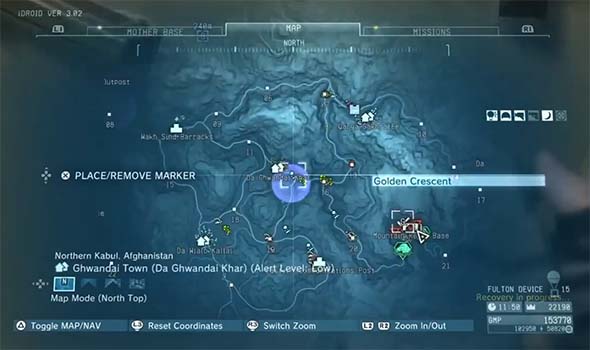
The Afghanistan map of Metal Gear Solid V feels heavily constrained by sheer cliffs.
Think about it this way: in a linear game with rooms and corridors, every hallway and room should serve some purpose or function. In most games, this function will be some kind of skill or system mastery test. An action game like Devil May Cry will throw enemies at you to fight; a puzzle game like Portal will have a puzzle (or a piece of a puzzle) in the room to solve; a stealth game like Metal Gear Solid 3 will have a sneaking challenge or obstacle to pass; and so on. In the best games, each of these challenges will also provide a unique or novel test of skill or system mastery: unique combinations of enemies, unique puzzles, or novel arrangements of enemies and obstacles. Other games can use those rooms for thematic or narrative purposes. A survival horror game like Resident Evil or Silent Hill will usually put enemies, puzzle items, or supplies in a room, but some rooms might instead contain a scripted scare. In some cases, a room might even be left completely empty in order to build some kind of tension or anticipation, or to delay the release of already-built tension or anticipation.
So what is the gameplay purpose of an open world map? ... [More]
d6e62cdb-b171-437a-b1a7-107859c9c818|4|4.5
Tags:open world, sandbox, game design, map, paradox, traversal, travel, cartography, geography, narrative, ludonarrative, ludonarrative dissonance, quest, exploration, driving, racing, vehicle, Ubisoft, Bethesda, Beenox, Metal Gear Solid V: the Phantom Pain, Assassin's Creed, the Amazing Spider-Man, Spider-Man, web-swinging, The Elder Scrolls, Skyrim, The Witcher 3, Fallout, Mad Max, Far Cry

After 2012's Amazing Spider-Man tie-in game presented some interesting ideas, I was really hoping that Beenox would have an opportunity to take the things they'd learned and apply them to a new, stand-alone Spider-Man game that would not be constrained to the plot and release schedule of a film tie-in. Sadly, that hasn't happened yet, and we have a new movie tie-in game that suffers from almost all of the problems associated with a movie tie-in.
Once again, Beenox was smart enough to know better than to follow along with the movie's asinine plot and opted to write their own side-story. Unfortunately, this one isn't as well written or as well presented as the previous game. It could have been a good story, but plot is clumsily-executed, and the associations to the movie only drag it down further.
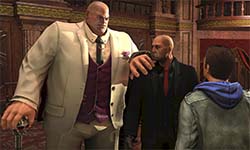
The Kingpin is comically (and ridiculously) oversized.
The bulk of the story is based around Wilson Fisk (the Kingpin) using rising crime rates as an excuse to deploy his private anti-crime task force in New York city. His company partners with Oscorp (who supplies the task force with its tech), and sells the task force to the public as a way of stopping crime and ending the vigilante justice that has plagued the city. But secretly, the task force is really out to destroy rival crime bosses and give Kingpin a monopoly on New York's organized crime underworld.
There's another secondary plot about hunting down the serial killer Cletus Kasady, who is killing criminals. This plot is only barely tied to the Kingpin thread, but it takes center stage during a large chunk of the second act of the game, and almost seems to become the main story - almost as if the writers couldn't decide if they wanted the game to be about Kingpin or about Carnage.
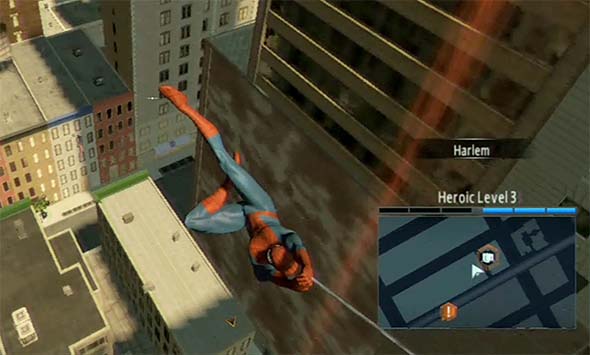
Web-swinging uses pseudo-physics that requires more active involvement from the player.
It's more rewarding than the prevoius game, but still not up to the level of earlier Spider-Man games.
Aside form a couple obligatory super villain boss fights with Electro and Green Goblin (Harry Osborn), the game has very little relation with the movie on which it is supposedly based... [More]
6f3d4582-799b-44ef-9867-65312fc53095|0|.0
Tags:The Amazing Spider-Man 2, Spider-Man, Kingpin, Electro, Green Goblin, Carnage, Shocker, Black Cat, open world, New York, Manhattan, web-swinging, Beenox, Activision, Steam, movie tie-in
This review was originally published 03/13/2011 on Game Observer (now defunct). It has been republished here for archival purposes.
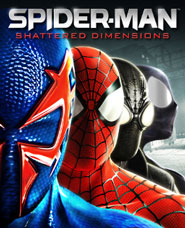
Beenox combines several different styles of gameplay and visuals into a fairly enjoyable but very short, disjointed, and sometimes unstable Spider-Man adventure.
I’m so glad that the last few Spider-Man games have not been constrained to follow a movie’s plot. Even though the Spider-Man 2 movie game was arguably the best Spider-Man game since the first one on the PS1, I really want to see developers try something a little more creative with the Spidey character. I’m one of the people who thoroughly enjoyed Web of Shadows and was really hoping to see further development with that game’s fantastically tight controls and combat mechanics. But Beenox had different ideas for a Spidey game – much more ambitious and creative ideas. They scrapped the free-roaming open New York and web-swinging mechanics that have become a staple of Spider-Man games since the second movie game in favor of a dimension-hopping beat-em-up. It’s actually a nice change of pace.
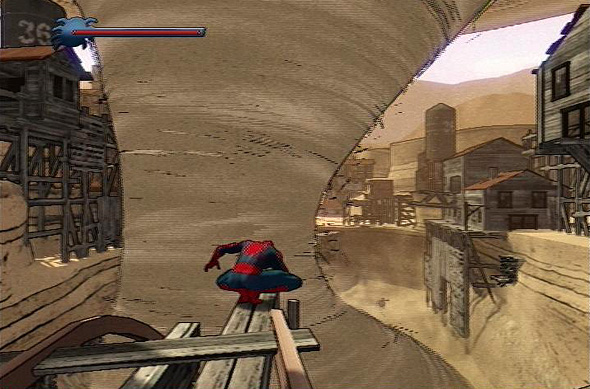
This battle against the Sandman early in the game is one of several exceptional action set-pieces. [More]
e969811e-9638-44a8-a696-0090f9c5fc52|2|5.0
Tags:Spider-Man: Shattered Dimensions, review, Spider-Man, Ultimate Spider-Man, Spider-Man Noir, Spider-Man 2099, Activision, Beenox, PC, PS3, Wii, action, adventure, platformer, stealth, comic book, parallel dimensions, Batman: Arkham Asylum, Neil Patrick Harris, XBox 360
|

| 12 | | | | | | | 60 | | 11 | | | | | | | 55 | | 10 | | | | | | | 50 | | 09 | | | | | | | 45 | | 08 | | | | | | | 40 | | 07 | | | | | | | 35 | | 06 | | | | | | | 30 | | 05 | | | | | | | 25 | | 04 | | | | | | | 20 | | 03 | | | | | | | 15 | | 02 | | | | | | | 10 | | 01 | | | | | | | 05 |
|